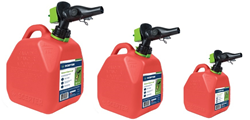
Scepter SmartControl fuel containers feature childproof spouts. The fold-flat child lock makes it almost impossible for young children to get gas out of a fuel container.
Items that can be found around the home, such as batteries, lighter fluid, gasoline and even nail polish remover, should be safety stored away from children.
MIAMI, Okla. (PRWEB)
March 05, 2020
Keeping people safe from poisonous solids, liquids, sprays and gases is the focus of National Poison Prevention Week, March 15-21, 2020.
Established in 1961 by Congress, National Poison Prevention Week seeks to raise awareness, reduce unintentional poisonings, and promote poison prevention. It is sponsored by the National Poison Prevention Week Council, a division of Health Resources & Services Administration of the U.S. government.
“Unintentional digestion of poisonous materials can have lasting harmful effects,” says Daniel Marshall, vice president of marketing and business development with Scepter™. “Items that can be found around the home, such as batteries, lighter fluid, gasoline and even nail polish remover, should be safety stored away from children.”
Keeping Fuel Away from Children
According to the 2019 National Poison Prevention Week presidential proclamation, more than 90 percent of accidental poisonings occur in the home, and children are particularly vulnerable. The proclamation states that each year, an average of 85,000 children visit emergency rooms across the country to receive care after exposure to poison.
Fuel is a poison that should be kept securely away from children. More than a decade ago the United States Consumer Product Safety Commission mandated specially-designed safety operating systems be added to fuel containers to add a layer of child safety regarding fuel containers. Additional rulings and standard updates have taken place since that time, all with the goal of keeping children safe from fuel.
While first generations of the child-safety operating systems were difficult to use, recent changes have gained widespread approval from homeowners. Over the years, manufacturers have fine-tuned child-resistant containers, making them easier for general operation but still difficult for children to use.
A New Generation of Easy-to-Use Fuel Containers
“We created our Scepter SmartControl™ fuel containers with childproof spouts that are a step above other containers in the marketplace,” says Marshall. “The fold-flat child lock provides a design that makes it easy to fill a mower with a simple squeeze. However, it’s almost impossible for young children to mistakenly get gas out of the container.”
The spout on the SmartControl fuel containers has a squeeze controlled flow rate, making it easy to fill everything from lawnmowers to ATVs to snow blowers without spilling a drop. That safety feature eliminates the chance of poisonous fuel accumulating on a garage floor, driveway or lawn.
With a single motion, the user simply presses the lever up to unlock the child safety feature with the palm of the hand, and then squeezes the large button. This first squeeze is done when upright to vent the container. Then, place the nozzle over the tank and squeeze again to pour just the right amount of fuel.
10 Fuel Safety Tips
According to Marshall, even adults can make a mistake when dealing with fuel and fuel containers. Key safety tips to keep in mind during National Poison Prevention Week and throughout the year include:
Tip #1 – Never siphon fuel by mouth.
Tip #2 – Recognize that fuel vapors can be ignited by an ignition source many feet away; do not smoke when using a fuel container.
Tip #3 – Avoid prolonged breathing of fuel vapors and remember to store and use fuel in well-ventilated areas.
Tip #4 – Keep fuel containers away from flame, pilot lights, stoves, heaters, electric motors and other sources of ignition.
Tip #5 – Keep fuel containers closed and out of reach of children and pets. Safely store them in a garage, barn or shed.
Tip #6 – Never remove or alter the flame mitigation devise (FMD) inside the opening of the container. The FMD is a safety device intended to reduce the chance of some types of fires and explosions.
Tip #7 – Do not pour fuel directly onto or near a flame, coals, embers or any other source of ignition. And never use fuel to start or accelerate a fire.
Tip #8 – Use fuel containers outdoors only; storing or using gasoline in the home or in a vehicle is a health hazard.
Tip #9 – Never try to kill ant hills or bee hives by pouring gasoline on them; fuel should never be used for these purposes.
Tip #10 – Gasoline can be fatal if swallowed. Do not induce vomiting. Call 911 immediately. For more insights visit the HRSA poison help document.
For those homeowners needing new or additional fuel containers, investing in easy-to-use SmartControl fuel containers is a smart move. Available in one-, two- and five-gallon gas, kerosene and diesel sizes, the durable SmartControl containers can be filled and safely stored when not in use.
Recognized by This Old House magazine as a “Top 20 Best New Product of 2019” in the Lawn & Garden category, SmartControl containers are also the recipient of the “Best in Class” Award at the 2018 National Hardware Show. Constructed in the U.S.A. of durable and safe high-density polyethylene, SmartControl containers can be found throughout the U.S. in The Home Depot®, Walmart®, Lowe’s®, AutoZone®, Pep Boys, Target and Northern® Tool + Equipment stores. Visit http://www.scepter.com for more information.
Share article on social media or email:

